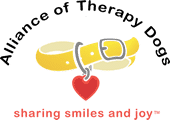The human end of the leash is just as important as the dog when it comes to therapy dog visits. Our job, as the handler, is to keep eyes on our dog at all times so we can be reading how they are feeling. A dog’s feelings can change in a second, at any time. Since dogs cannot speak, they use their body language to let us know how they feel.
While the general public can usually recognize very obvious body language signals, there are many small changes in our dogs’ body language that we can notice sooner. Sometimes, when our dogs start showing those obvious body language signals, it’s too late. This is why it is important to have experience in reading your dog’s body language before beginning your therapy dog journey. Alliance of Therapy Dogs is proud to provide a Body Language brochure to our Members and the public. You can find this on our website and in your ATD Member Portal. Let’s break down what the graphics on our brochure are telling us.
Green Light

These graphics depict dogs with comfortable, relaxed body language. Note the relaxed, loose way their bodies are positioned, their joints are not stiff. These dogs would approach someone to visit with wiggles; whether they would be a little more excited or very soft and fluid would depend on the dog. The dogs in this graphic carry their tail in a comfortable position. This position is dependent on breed. The tails are not too high or too low (exceptions are made for dogs who naturally carry their tail high over their back or down between their legs). The tail would move softly, it would not be rigid or tight, even when wagging (almost like it is forcibly vibrating). The muzzle, eyes, and ears are soft. They do not have a hard stare or ears that are very rigid and stiff. The edges of their mouths are relaxed and not pulled back tight. The panting dogs have a relaxed tongue that hangs gently out of their mouths.
Yellow Light

These graphics depict dogs that may be in some sort of stress. Some of this stress could be good or bad, but it is up to you, the handler, to determine that on your visit. The dog’s bodies in these graphics would show a little more stiffness, the tail may still be at a comfortable position, but may become a little stiffer in its wag. The dog’s ears are rigid, held to the sides, back, or flat against the sides of their head. The muzzles are tense, either by pulling the edges of their mouth tighter, giving the appearance of a smaller mouth, or by pulling back towards their ears. This is especially visible in the panting dog. The tongue is tight and rigid, not flopping around its mouth. If your dog does not normally pant, this can be a sign your dog is stressed. Your dog may lick their lips repeatedly when there is not food present or it may appear your dog is just sticking the tip of their tongue out of their mouth repeatedly. If you just arrived to your therapy visit and your dog is already yawning, this can be a sign of stress.
Red Light

These signals include the more obvious signs that your dog is uncomfortable. If you are aware of your dog’s body language, you should have already left your therapy dog visit before you see these signals. However, if you have not been aware of what your dog is telling you, this is when you need to excuse yourself from your visit. The dogs in these graphics are clearly not comfortable with visiting any longer. They are hiding in corners, behind objects, or their handler. They are shying away from hands as people reach towards them and are trying to shrink their body size by curving under or away. The middle dog is shaking. The dog on the bottom is losing excessive amounts of fur (this will vary depending on breed). If your dog begins shedding excessively or shedding with dandruff, this is a sign they are under stress. Ears are back, flat against their head. The eyes are staring or giving whale eye. Whale eye is when the dog’s head is facing away but the dog keeps their eyes on what is making them nervous, which shows the whites of their eye. These dogs clearly do not want to be in this situation.
Understanding a dog’s body language takes practice. These signals can change within seconds and a skilled therapy dog handler will be see them on therapy dog visits. This is why it is important to keep your dog in front of you and to always have them near you. Sometimes you only have a split second to get your dog out of an uncomfortable situation. If you become a skilled canine body language reader, you will be the best handler you can be for your dog. Watching videos on YouTube or watching dogs out in public are great ways to practice reading dog body language. There are many good books and resources on canine body language available for those looking to learn more. When it comes to therapy dog visits, knowledge is power!


